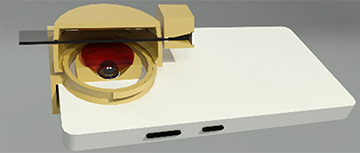
DIY multi-color fluorescence microscopy system attached to a smartphone. [Image: University of Houston]
A research team led by Wei-Chuan Shih from the University of Houston, USA, reports creating a multicolor fluorescence microscope from a smartphone and a 3-D printer—and they’ve made the computer-aided designs available online for free (Biomed. Opt. Express, doi: 10.1364/BOE.8.005075). The scientists say the smartphone microscope, outfitted with a 3-D inkjet-printed elastomer lens and a polylactic-acid (PLA) housing, could help equip researchers and healthcare providers in developing and rural areas, as well as hobbyists and backpackers, with imaging techniques for diagnostic functions, including detecting waterborne pathogens.
According to researchers, the new DIY tool is capable of autofluorescence, fluorescent stains and immunofluorescence—three common types of investigative fluorescence microscopy. And it’s also, they say, not only less expensive than traditional benchtop microscopes, but easier to use.
Simple and printable
Fluorescence microscopy has been difficult to scale down to an easily accessible, portable platform, because the method requires accurate optical alignment and precise, directional illumination—that is, expensive filters and objective lenses, and a repositionable light source. Shih’s group says it has overcome these hurdles by equipping its smartphone microscope with interchangeable self-adhesive lenses and a fixed, side-launched light source, which together simplify optical alignment and illumination.
The 3-D-printed polymer lenses self-adhere to the phone’s camera lens and need minimal centering for optical alignment. The other 3-D-printed parts, composed of PLA, include an adaptor fitted onto the phone’s camera-end; an adhesive ring with a color filter to remove stray light from the system; a base ring attached to the adapter; a threaded barrel for z-axis focusing and a slot for inserting sample slides; a lid to block ambient light; and a module that holds five surface-mounted light-emitting diodes (LEDs) for sample illumination.
Fluorescence from a fixed distance
The side-mounted LEDs eliminate the need for an adjustable light source for different lenses or emission filters. Light from the LEDs is launched across a standard 1-mm-thick glass slide, providing illumination guided by total internal reflection between the top and bottom glass/air interfaces. The sample, which rests on the glass slide, couples out the illumination. The elastically scattered photons are blocked by the filter in the adhesive ring, while the fluorescent photons can reach the elastomer lens on the phone’s camera.
Images from the fluorescent photons are first converted to an uncompressed digital-negative format, and then decoded to a lossless TIFF images for viewing in-phone and exported to a computer for further processing.
Imaging parasites in water
![]()
Wei-Chuan Shih [Image: University of Houston]
Shih and his team used their smartphone microscope to image water samples containing Giardia lamblia and Cryptosporidium parvum—two types of waterborne parasites—via multicolor immunofluorescence. Compared with images they captured using a tabletop fluorescence microscope, their smartphone images had a slightly lower resolution (2 µm with deconvolution). However, the researchers were still able to differentiate parasites from similarly sized polystyrene beads in the water samples.
The researchers say the entire smartphone attachment weighs 26.5 grams, can operate for one hour on two 1.5-V button batteries, and costs less than US$20 to make. They hope that eventually the technology could be used to bring on-site analysis, on-demand monitoring and point-of-care diagnostics to nearly anyone, anywhere.
Making it open
In a press release, Shih commented the decision to make instructions for building the device open to all. “I think it [the smartphone microscope] will have more impact if we let people play with it, rather than trying to hold it as a secret,” he said. “We should make it as easy and accessible as possible for everyone.” The open-source dataset is available for download here.
Back in 2015, Shih and his colleagues created an inkjet-printed lens that can turn a smartphone into a microscope. That project led to the lab creating a company, Dotlens, to produce and distribute the lenses.
